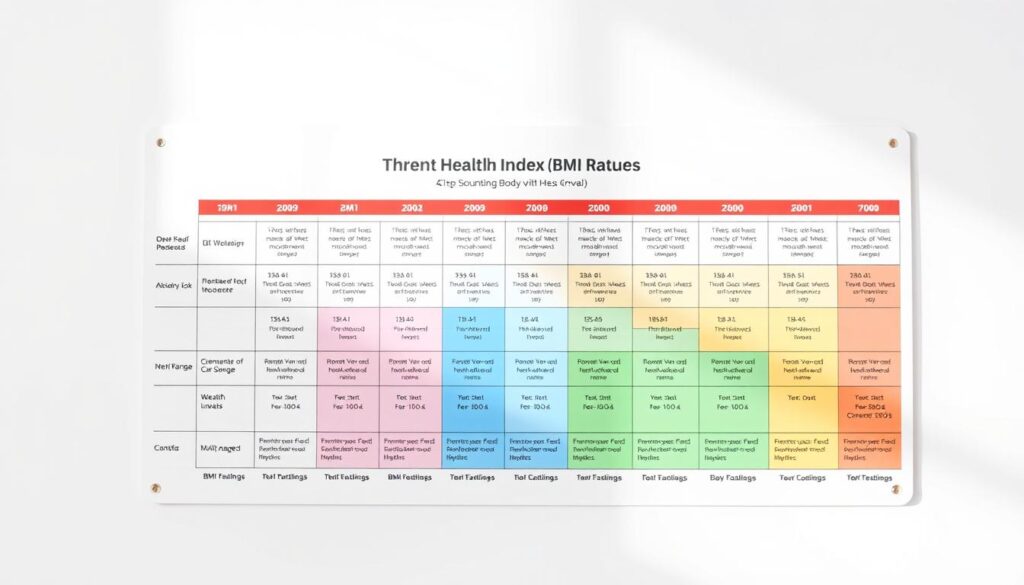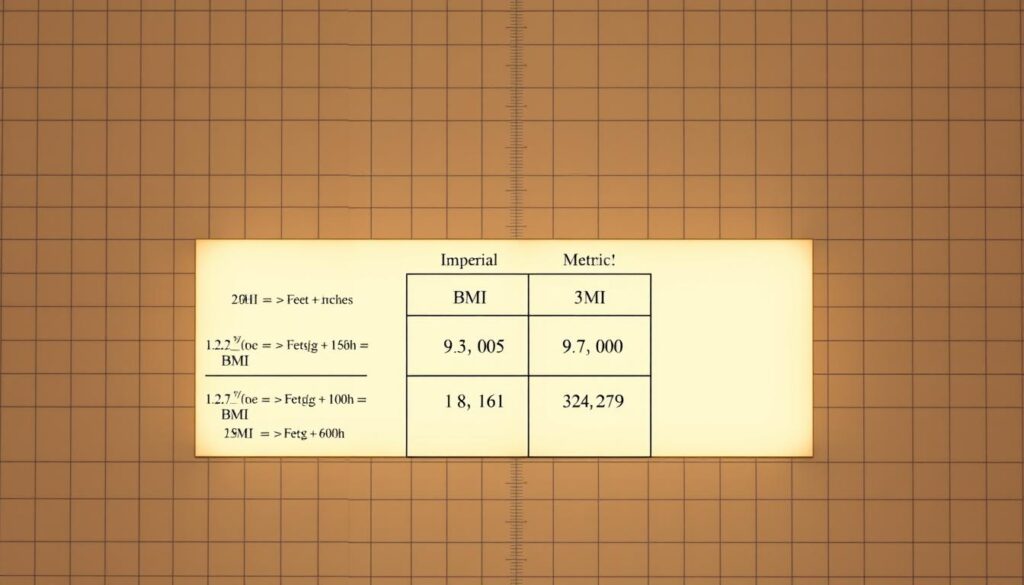Imagine having a tool that translates your height and weight into actionable insights about your well-being. Our custom-designed health assessment tool eliminates guesswork by letting you input measurements in feet and inches — no conversions needed. This approach aligns with how most Americans naturally track their physical metrics, making it easier to grasp your health status.
Body mass index (BMI) is a widely recognized indicator of health risks tied to weight. While the formula itself — (weight in pounds × 703) ÷ (height in inches squared) — remains consistent, our platform simplifies the math. For instance, entering 5’7″ automatically converts to 67 inches, paired with your weight in pounds for instant results. We prioritize precision, whether you’re tracking progress or establishing baseline metrics.
Accurate inputs matter. Digital scales and proper measurement techniques ensure reliable outcomes, as outlined in our guide to using weight measurement tools effectively. While BMI categories provide helpful benchmarks, we encourage combining this data with other health markers for a complete picture.
Key Takeaways
- Our tool simplifies health assessments using familiar measurement units
- Automatic unit conversions ensure error-free calculations
- Precise inputs lead to more reliable health insights
- BMI ranges should be considered alongside lifestyle factors
- Regular tracking helps identify meaningful health trends
Understanding Body Mass Index and Its Importance
Health assessments often begin with a key metric used across healthcare systems. Body Mass Index (BMI) measures body fat using a person’s weight relative to their height. Organizations like the CDC and WHO recognize it as a screening tool for potential health risks linked to weight extremes.

What BMI Reveals About Wellness
The formula divides weight in pounds by height in inches squared, multiplied by 703. Results fall into four categories: underweight (below 18.5), normal (18.5–24.9), overweight (25–29.9), and obese (30+). These ranges help identify elevated risks for conditions like heart disease or diabetes.
Interpreting Results Across Populations
Age and gender influence outcomes.
Women often have higher body fat percentages than men at the same BMI. Older adults may naturally lose muscle mass, affecting readings. For personalized insights, pair this data with effective weight management strategies.
While useful, BMI doesn’t account for muscle mass or bone density. Athletes might register as overweight despite being healthy. Always consult healthcare providers to contextualize results within your unique health profile.
How to Use Our BMI calculator with height in feet and inches
Mastering your health data begins with simple inputs. Our platform transforms everyday measurements into meaningful insights using units you already understand. Follow these straightforward methods to get precise results every time.
Step-by-Step Instructions
Start by removing shoes and standing straight against a wall. Use a tape measure to record your height in feet and inches. Enter these numbers separately into the designated fields — our system automatically converts them to total inches.

Next, step onto a calibrated scale wearing light clothing. Record your weight in pounds to the nearest half-pound. Input this value into the corresponding box. The tool instantly processes your data using this formula:
BMI = (weight in pounds × 703) ÷ (height in inches²)
| Feet | Inches | Total Inches |
|---|---|---|
| 5 | 7 | 67 |
| 5 | 11 | 71 |
| 6 | 0 | 72 |
Measurement Best Practices
For consistent results, measure at the same time each day. Morning readings often provide the most stable weight measurements. Place scales on hard flooring — carpeted surfaces can skew results by up to 10%.
When tracking height, stand with heels together and eyes looking forward. Use a book or ruler placed horizontally on your head for accurate alignment. These techniques ensure your health profile reflects true metrics.
BMI Calculation Methods and Units
Health metrics become meaningful when measurements align with your daily language. We offer two approaches to assess body composition — one using pounds/feet and another with kilograms/meters. Both methods deliver identical insights through distinct mathematical pathways.

Calculating BMI Using US Units
Our platform uses this equation for imperial measurements:
(Body weight (lbs) × 703) ÷ (Height (in) × Height (in))
For a 180-pound individual standing 5’9″:
- Convert height: 5 feet = 60 inches + 9 inches = 69 inches
- Calculate: (180 × 703) ÷ (69 × 69) = 26.6
| System | Formula | Multiplier |
|---|---|---|
| Imperial | (lbs ÷ inches²) | 703 |
| Metric | (kg ÷ meters²) | None |
Understanding Metric Conversions
The metric formula simplifies calculations:
Mass (kg) ÷ Height (m)²
A 75kg person measuring 1.78m would compute:
- 1.78 × 1.78 = 3.17
- 75 ÷ 3.17 = 23.7
These index measurements correspond to universal categories:
- Under 18.5: Below ideal range
- 18.5–24.9: Healthy levels
- 25+: Elevated health risks
Our tool automatically converts units when needed, ensuring precise comparisons across measurement systems. Always verify inputs against standardized charts for consistent health evaluations.
Practical Examples and Considerations for All Ages
Health evaluations adapt across life stages, requiring tailored approaches for adults and growing individuals. Our analysis combines real-world scenarios with expert guidance to help you interpret results effectively.
Adult Health Profiles
A 40-year-old woman measuring 5’6″ (66 inches) and weighing 160 pounds would calculate:
- (160 × 703) ÷ (66 × 66) = 25.8
- This places her in the overweight category per standard charts
However, a 200-pound athlete at the same height might show identical results despite low body fat. Muscle density significantly impacts these measurements, highlighting why personalized assessments matter.
Youth-Specific Metrics
The Centers for Disease Control uses growth charts for those under 20. A 12-year-old boy at the 85th percentile faces different health risks than an adult with similar numbers. Key factors include:
- Age-specific percentile rankings
- Growth pattern variations
- Body composition changes during puberty
Regular physical activity and heart health monitoring become crucial when tracking youth development. Combine these observations with professional medical advice for comprehensive care.
While weight-related conditions like diabetes remain concerns, remember that numbers alone don’t define wellness. Pair measurements with blood pressure checks and fitness evaluations for complete health insights.
Conclusion
Taking charge of your wellness starts with reliable tools and clear insights. Our platform transforms everyday measurements into meaningful health snapshots using units you already understand. We’ve shown how precise inputs — from body composition to growth patterns — create accurate health profiles across life stages.
Following measurement best practices ensures your results align with guidelines from trusted sources like the Centers for Disease Control. Remember that muscle mass and fat distribution influence outcomes, which is why we emphasize pairing numbers with professional advice. Our system handles unit conversions seamlessly, whether tracking progress or establishing baselines.
Regular check-ins help spot trends early, especially when managing risks tied to weight-related conditions. We invite you to explore our resources for maintaining healthy habits and making informed choices. Together, let’s build stronger foundations for lifelong well-being — one measurement at a time.

